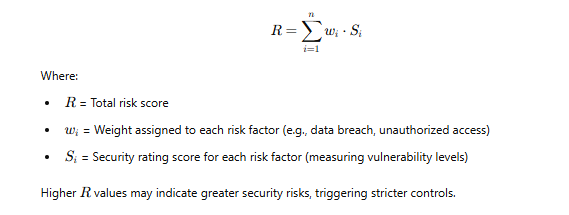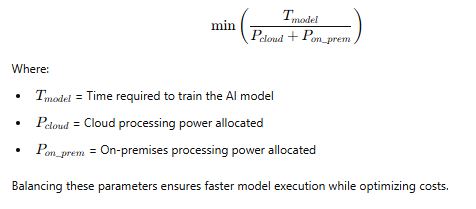Hybrid Cloud Strategies for AI-Driven Insurance Operations: Balancing Security, Compliance, and Cost Optimization
 BALAJI ADUSUPALLI
BALAJI ADUSUPALLI
Abstract
The integration of artificial intelligence (AI) in insurance operations has improved risk assessment, fraud detection, and customer engagement. However, deploying AI solutions at scale requires robust infrastructure that ensures data security, regulatory compliance, and cost efficiency. This research explores the role of hybrid cloud strategies in enabling AI-driven insurance operations, highlighting best practices for achieving security, compliance, and cost optimization.
Introduction
The insurance industry is increasingly embracing AI to streamline operations, enhance customer experiences, and improve decision-making processes. However, given the sensitive nature of insurance data, organizations face challenges in balancing security, regulatory mandates, and infrastructure costs. A hybrid cloud strategy, which combines on-premises infrastructure with public and private cloud services, offers a flexible solution to meet these demands.
Cost Optimization Model

The Need for Hybrid Cloud in AI-Driven Insurance Operations
AI-driven insurance solutions rely heavily on data for training models, analyzing claims, and detecting fraud. Key factors necessitating a hybrid cloud strategy include:
Data Sensitivity: Insurance data contains confidential personal and financial details that must remain secure.
Regulatory Compliance: Compliance with standards such as GDPR, HIPAA, and PCI-DSS requires strict data governance policies.
Cost Efficiency: Balancing on-premises resources with scalable cloud services minimizes costs while ensuring optimal performance.

Key Components of a Hybrid Cloud Strategy
A well-structured hybrid cloud strategy for AI-driven insurance operations should include the following components:
1. Data Segmentation and Storage Management
Sensitive data (e.g., personally identifiable information) should reside in secure on-premises systems or private clouds to meet compliance requirements. Non-sensitive data, such as training datasets or anonymized information, can be stored in public cloud environments to reduce costs.
2. AI Model Training and Deployment
Model training often demands significant computational resources. Insurers can train models in the cloud to leverage on-demand scalability and advanced GPU infrastructure. After training, these models can be deployed on-premises or in private clouds for secure inferencing.
3. Security and Encryption Protocols
Hybrid cloud environments must adopt end-to-end encryption, robust firewalls, and identity access management (IAM) to mitigate risks. Techniques such as homomorphic encryption ensure sensitive data remains encrypted during AI model computations.

4. Compliance Framework Integration
Cloud providers offer specialized tools that assist insurers in aligning with data protection regulations. Solutions such as AWS Artifact, Azure Compliance Manager, and Google Cloud Security Command Center help enforce governance policies.
5. Cost Optimization Strategies
Hybrid cloud environments must balance performance with cost efficiency. Best practices include:
Dynamic resource allocation for AI workloads.
Spot instances for non-critical training jobs.
Serverless computing for lightweight AI functions
Risk Assessment and Compliance Score

.
Implementation Framework for AI-Driven Insurance Operations
A successful hybrid cloud implementation involves the following steps:
Assessment and Planning: Identify data types, security risks, and AI workload requirements to inform infrastructure design.
Cloud Service Selection: Choose appropriate cloud providers based on security certifications, scalability, and integration capabilities.
Model Deployment Strategy: Utilize CI/CD pipelines to automate model deployment across hybrid cloud environments.
Performance Monitoring: Implement AI model observability frameworks to monitor performance, accuracy, and cost metrics.

Case Study: Hybrid Cloud in Fraud Detection
An insurance company deployed a hybrid cloud model to enhance fraud detection in real-time claims processing. The following approach was adopted:
On-Premises Data Management: Customer records and sensitive policy data remained on-premises to comply with data protection regulations.
Cloud-Based Model Training: The insurer utilized Google Cloud AI for model training, leveraging TPU infrastructure to process extensive claim data.
Hybrid Deployment: The trained model was deployed across both cloud and on-premises systems, ensuring secure inferencing while optimizing costs.
Results:
30% Reduction in cloud expenses by using dynamic resource allocation.
40% Improvement in fraud detection accuracy due to improved model scalability and rapid retraining cycles.
. Resource Allocation Optimization for AI Workloads

Challenges in Hybrid Cloud Adoption
Despite its benefits, hybrid cloud strategies pose challenges such as:
Data Synchronization: Ensuring seamless data flow between cloud and on-premises systems requires effective integration frameworks.
Compliance Complexity: Managing multi-region data residency regulations demands meticulous planning.
Skill Gaps: Organizations may require cloud architects, data engineers, and cybersecurity specialists to manage complex hybrid environments.
Future Directions
Future advancements in hybrid cloud strategies for AI-driven insurance operations may include:
AI-Optimized Cloud Architectures: Enhanced GPU accelerators and distributed computing frameworks tailored for large-scale AI model deployment.
Federated Learning: This decentralized approach allows insurers to train AI models across multiple data sources without exposing sensitive information.
AI-Driven Cloud Cost Optimization Tools: Predictive analytics solutions that dynamically adjust cloud resources based on AI workload patterns.

Conclusion
Hybrid cloud strategies provide insurers with a powerful solution to balance security, compliance, and cost optimization in AI-driven operations. By integrating secure data storage, scalable AI training frameworks, and advanced security protocols, insurers can achieve improved risk assessment, fraud detection, and customer personalization. As the insurance industry continues to evolve, embracing hybrid cloud strategies will be essential for maintaining competitiveness in the digital landscape.
Subscribe to my newsletter
Read articles from BALAJI ADUSUPALLI directly inside your inbox. Subscribe to the newsletter, and don't miss out.
Written by
